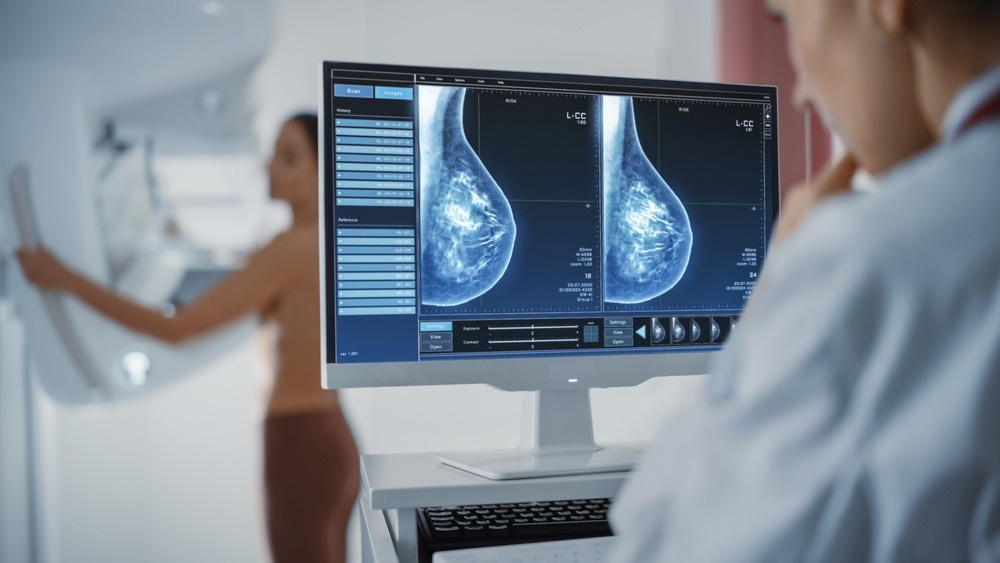A device that can do Clinical Breast Examinations (CBEs) has been developed by researchers.

Image Credit: Gorodenkoff/Shutterstock.com
The manipulator, developed by a team at the University of Bristol and headquartered at the Bristol Robotics Laboratory, can apply highly exact pressures across a range equivalent to that used by human examiners and can identify lumps at greater depths than previously possible.
This might change the way women monitor their breast health by providing them with safe electronic CBEs in conveniently accessible locations such as pharmacies and health centers that deliver reliable results.
Precision, reproducibility, and accuracy are critical in tactile medical examinations to promote positive patient results. A variety of automatic and semi-automatic technologies have been proposed to help in optimizing this work, particularly for difficult-to-identify and hard-to-reach circumstances such as those encountered during minimally invasive surgery.
Dr. Antonia Tzemanaki of Bristol Robotics Laboratory led the study team, which comprised a mix of postgraduate and student researchers.
There are conflicting ideas about how useful carrying out Clinical Breast Examinations (CBE) are for the health outcomes of the population. It is generally agreed upon that if it is well performed, then it can be a very useful and low risk diagnostic technique.
George Jenkinson, Study Lead Author and Doctor of Philosophy, School of Electrical, Electronic and Mechanical Engineering, University of Bristol
Jenkinson added, “There have been a few attempts in the past to use technology to improve the standard to which healthcare professionals can perform a CBE by having a robot or electronic device physically palpate breast tissue. But the last decade or so of technological advances in manipulation and sensor technology mean that we are now in a better position to do this. The first question that we want to answer as part of this is whether a specialized manipulator can be demonstrated to have the dexterity necessary to palpate a realistic breast size and shape.”
The team created their manipulator using 3D printing and other Computer Numerical Control techniques, and they used a combination of laboratory experiments and simulated experiments on a fake (silicone) breast and its digital twin, both of which were modeled on volunteers at Imperial College London’s Simulation and Modelling in Medicine and Surgery research group.
The simulations enabled the researchers to run thousands of palpations and evaluate a wide range of possible scenarios, such as estimating the efficiency difference between employing two, three, or four sensors at the same time.
They were able to conduct experiments on the silicone breast in the lab to confirm the simulations’ accuracy and to empirically determine the stresses for the actual equipment.
Jenkinson further stated, “We hope that the research can contribute to and complement the arsenal of techniques used to diagnose breast cancer, and to generate a large amount of data associated with it that may be useful in trying to identify large scale trends that could help diagnose breast cancer early. One advantage that some doctors have mentioned anecdotally is that this could provide a low-risk way to objectively record health data. This could be used, for example, to compare successive examinations more easily, or as part of the information packet sent to a specialist if a patient is referred for further examination.”
The researchers will next integrate CBE skills learned from professionals with AI and completely equip the manipulator with sensors to verify the overall system’s performance at spotting possible cancer risks.
The ultimate objective is for the devices and sensors to be able to identify lumps more accurately and deeply than is now achievable with human touch. It might potentially be used in conjunction with other current methods, such as ultrasonic examination.
“So far, we have laid all of the groundwork. We have shown that our robotic system has the dexterity necessary to carry out a clinical breast examination—we hope that in the future this could be a real help in diagnosing cancers early,” Jenkinson concluded.
This study was part of the ARTEMIS project, which was financed by Cancer Research UK and supported by the EPSRC.